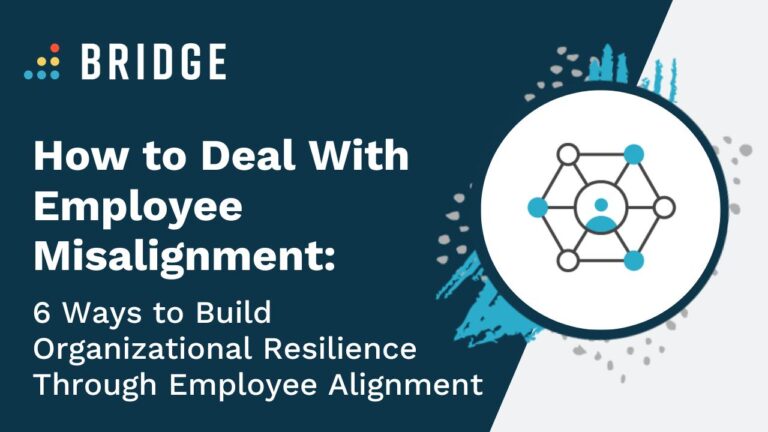When you’re building your organizational resilience, it’s crucial to address factors that might actively undermine your efforts. Failure to do so means that any positive steps you take are built on shaky foundations.
One such factor is employee misalignment, and understanding what it is, being aware of its warning signs, and knowing the steps to take are the crucial first steps in your journey towards building organizational resilience.
What Is Employee Misalignment?
If an employee doesn’t see the value in your organization’s purpose, vision, and values, or they simply don’t understand how their role adds value, that’s misalignment. This can be a big hurdle to overcome. If employee goals and company goals are misaligned, it can create friction, and even cause decreased performance and productivity among teams.
Tackling misalignment needs to be a company-wide initiative—changing one aspect of your culture while leaving the rest of the system intact can actually fuel further misalignment. This is also why alignment needs to be a constant consideration when tackling the lack of resilience in your organization. Any changes you make must always factor in the possibility of accidentally creating a source of misalignment.
RELATED READING | ‘Get Aligned: 3 Ways to Keep Employees Aligned With Organizational Goals’
How to Recognize Employee Misalignment
Keep an eye out for some of these signs of misalignment in your organization:
1. Workplace Tension
A misaligned employee can quickly become a resentful employee. If they don’t feel that they’re heading in the same direction as their peers or have trouble seeing a common goal, that dissatisfaction can bleed into antagonistic workplace behavior.
2. Poor Employee Connection
When teams are misaligned, it’s likely that they want different and conflicting things, making it harder for them to connect. A poor connection will lead to poorly focused results or even project delays as you try to reconcile the differences.
If there isn’t a culture of clear communication across your organization, you can’t expect your employees to be on the same page. This can fuel misalignment as muddled communications from the top, unclear manager instructions, or poor communication between employees will lead to confusion and may even set your teams on the wrong path.
3. Lack of Employee Empowerment
An employee who doesn’t feel empowered in their role and who feels like they are unlikely to be listened to is one who will stop trying to be heard. Their insights and valuable suggestions will be lost and they will never seek to improve the ways in which they engage with others. If you’re seeing this lack of communication and engagement, it could be a sign of misalignment.
4. Employees Missing Deadlines
Missed deadlines are a major source of stress in the workplace. These missed deadlines often stack up in the to-do list alongside even more deadlines. In this way, the workload rapidly becomes unmanageable. Keeping an eye on how your workforce is faring with deadlines is a way to detect an increasing disconnect between your employees and your organization.
5. Lack of Accountability
If people within your organization don’t take responsibility for their actions, this is a major cause of stress for the rest of the workforce. This can be a factor in employee disconnection and misalignment, which is why monitoring potential stressors is important.
6. Overwork and Burnout
All the factors mentioned above will ultimately lead to overwork and burnout. Both are inevitable consequences of tensions, poor connections, muddled communication, lack of empowerment, and rapidly approaching deadlines. If your employees are running to stand still, this might indicate that your company has a huge problem with alignment.
HANDPICKED FOR YOU | ‘How Connecting With Employees Helps Strengthen Organizational Resilience’
How to Build Organizational Resilience Through Company Alignment
Improving alignment across your company can yield significant rewards, as highly aligned companies have 36% higher growth than poorly aligned companies. So, how can you improve alignment in your company and, consequently, improve the resilience of your workforce?
Here are six ways to better align your organization:
For more ways to build organizational resilience, download the ebook, ‘5 Factors That Fuel a Resilient Workforce’.
1. Find Common Purposes
Aligned teams tend to think of their own work as connected to the success of the company. And it is, however many teams struggle with making that connection. You need a mission and vision to articulate a common goal throughout your entire organization, as this will give meaning to the work that each employee does.
2. Find Common Ground
It’s essential to understand that nobody thinks of themselves as the villain of the piece. If an employee has a different view of what alignment means then you need to listen to that viewpoint and not see it simply as obstructive. Finding common ground is the way forward, and it’s always important to challenge your own fixed mindset.
3. Identify Your Influencers
There will be employees in your organization whose word carries greater weight among their coworkers. Having those people on board with your corporate strategy will make the process of alignment far easier.
4. Keep Employees Talking
Employees should be aware of goals (whether they be OKRs, KPIs, or any other metrics) and not just wheel them out at annual review time. Keeping your workforce on the same page throughout the year is an important step in creating alignment and helping to feel as though each employee is working towards a common goal. Having regular conversations with employees can help to keep them aligned with their goals and aware of any changes as they occur.
5. Change the Narrative
Effective leadership means framing the narrative in a certain way. Instead of saying “that can’t be done”, change the narrative to “that might be difficult. How can we do that?” Positive framing of challenges facing employees and including them in how those challenges are dealt with goes some way to aligning them with your organization.
6. Align All Levels
Everyone has goals: the company as a whole has goals, the teams within that company have goals, and the people within those teams have personal goals. Addressing alignment across the whole company means dealing with each level.
MORE FROM THE BLOG | ‘3 Simple Ways to Enhance Employee Experience’
Looking for More Ways to Build Organizational Resilience?
Building organizational resilience doesn’t need to be a challenge, and it only takes a few simple steps.
To discover the five steps you should take—and the five to avoid!—download the ebook ‘5 Factors That Fuel a Resilient Workforce’.
Download the ebookFind a tool to keep your employees talking




